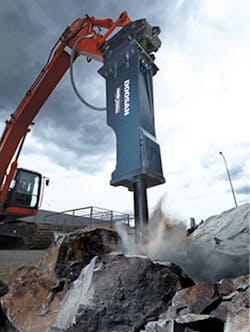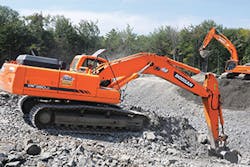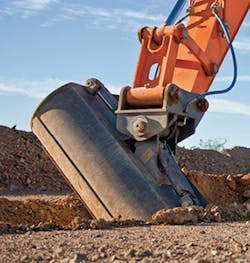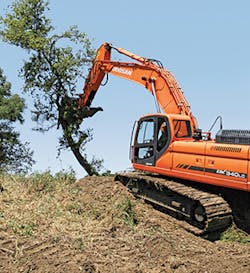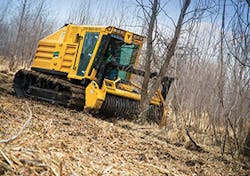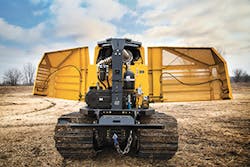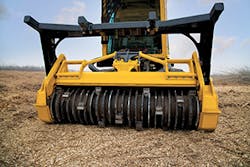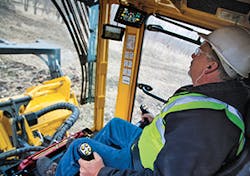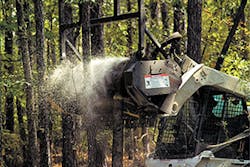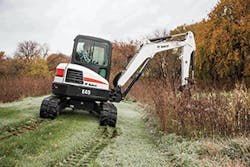Your company has successfully bid a job, and it’s time to examine the site for land clearing. What equipment will be essential? What is the process in tool selection for land clearing site preparation? How will the tools’ capabilities fit into that process, and throughout the project? How can common mistakes be avoided?
Industry experts say that the first factors to consider in selecting tools for land-clearing site preparation are to know the site requirements, job timeframe, amount to be cleared, and size of the material—including tree diameter—to be cleared.
“You will need equipment that matches the size of the job, the size of the trees that are being cleared, and the rate that you want to clear them,” notes Rob Wenzlick, Morbark regional sales manager.
Doosan Equipment hammers, digs, grabs, and scoops
To best match the site preparation machines and attachments to the job, Lee Smith, attachment product specialist for Doosan Infracore Construction Equipment America (Doosan), says that contractors also should evaluate the vegetation, ground conditions, and existing structures.
The process of selecting the right tools for the land-clearing site first depends on how the contractor is going to utilize the fleet, says Michael J. Boyle, product consultant manager, John Deere Construction & Forestry. The contractor selects machines that will stay with the project according to the final use of the site, such as a building, pipeline, or agricultural use.
The size of the machines will be determined by the size of the trees and final use of the trees, Boyle states. Harvesting machines will be used if the trees are going to be processed for lumber or pulp.
Doosan Equipment hammers, digs, grabs, and scoops
Dozers and excavators can be used for grubbing trees for stock piling or burning. Dozers, excavators, skidders, and a tub grinder/chipper will be used if chipping or grinding trees. A dozer pulling a disk may be used to chop or cut up small trees and underbrush.
“The bidding regulation for the site will determine if the trees are to be burned or chipped,” says Boyle. “These regulations will require different machines.”
The speed and intensity of the job will determine the number and size of machines and size of crews, Boyle points out. “Job conditions and terrain will determine attachments to be added for each machine,” he says. “For example, wide tracks will be required for wet soggy conditions, and single bar grousers add to excavator to hold on steep slopes.”
An excavator with thumb is ideal for all clearing processes, Boyle adds.
Doosan Equipment hammers, digs, grabs, and scoops
The dozer, in the past, has been the tool of choice and continues to be used by contractors, with the size chosen according to size of trees, terrain, and grounds conditions.
“A grinder and chipper will be added to the list of required machines if regulations require,” says Boyle, adding that the grinder and chipper will be loaded with excavator or four-wheel drive loaders.
“If the tree has value and there is a mill close, skidder or tree harvesting equipment will be used with 18-wheeler trucks for shipment to the mill,” he notes.
Excavator attachments may include a quick coupler and a rake for a quick coupler, or special buckets such as grubbing buckets to pull up mesquite trees. Tractor and disks can be used to chop up debris or underbrush.
In choosing the type of equipment that it takes to dispose of a certain size of material onsite, while large material obviously takes large machinery with material going off to a horizontal or tub grinder, it’s possible that a forestry mower can take care of a site at which the majority of the timber stand is comprised of smaller material, notes Brad Van Rheenen, application specialist for Vermeer.
Equipment choice is based on the time needed to get the job finished, says Van Rheenen. “The production rates of the machinery needs to equal the size of the material and the deadline on the job site: how big is the clearing site; how big is the material; what needs to be done,” he says.
Using a forestry mower to do the whole job would be a one-man operation—a semi-truck with a forestry mower on board with the size of the mower, depending on the size of the job. “If you have a large machine, you might be able to knock everything out with one machine,” says Van Rheenen.
Katie Althoff, product specialist for attachments for Bobcat, agrees that once the vegetation needs are established, a forestry cutter is able to selectively remove trees from among a significant amount of vegetation. That equipment also can handle larger brush, she says, adding that it’s also capable of mulching the material.
Bobcat’s Brushcat rotary cutter or a flail mower can handle grass and saplings, Althoff says.
A factor to consider, says Van Rheenen, is whether the material can be burned instead of ground up. He raises the questions: “If the terrain is real steep hillsides, do you need to go in there with a track machine or is a rubber-tired machine going to do the job? What is the project timeline? How much time is allotted for you to get the project finished?”
Other considerations are federal and state regulations that impact the job, such as whether there are endangered species present onsite, and if emerald ash bore is a concern.
Another factor is whether the client—such as the state government or a pipeline company—consents to the finished material being spread out on the ground. “A forestry mower is going to mulch up the entire site and all of the finished product is going to be laying all over the ground,” points out Van Rheenen. “If you have larger material, there is so much material left over that’s not acceptable, so you would have to bring in a chipper or horizontal grinder so you could either haul the material away or stockpile it as required.”
Vermeer FT300 mulcher at work. . .
The contractor should also determine how much they want to push the equipment, says Van Rheenen. “If it’s a fairly small site, and a few of the trees are larger than what a forestry mower could typically handle, he may just wrestle his way through it with the forestry mower, pushing the machine beyond its limits just a little bit to get the job done so they don’t have to freight the other support equipment out there,” he says.
While a cutoff point in equipment selection can be a moving target, as a general guide, a forestry mower of 100 to 120 horsepower needs to be used just for 6- to 8-inch-diameter material and under, says Van Rheenen.
Vermeer has a 300-horsepower unit “that can go up to as big of material as you’d like to put it in, but to be efficient, I feel you ought to keep that under 10 inches,” he says, adding anything beyond that will consume significant time and resources. “If you’ve got a lot of that kind of stand in your timber, you’d be bringing in a grinder or a chipper.”
. . . open for maintenance
Crawler excavators are most commonly operated for excavating, grading, and site preparation projects in dirt, says Smith, adding that, “they may be operated to dig and stabilize base material for future utility and pavement installations.”
In some instances, they may be used to remove existing structures or perform demolition tasks. For demolition tasks, contractors may rent an excavator and hydraulic breaker to remove concrete, and then return the excavator-breaker combination when that portion of the project is complete, Smith says.
Padraig Egan, territory manager–Northeast for Geith, points out that “rough, rocky terrain may require a hydraulic breaker and a severe duty rock bucket, while softer, more even ground may be better suited to a high-capacity bucket or an angle tilt bucket for land clearing, grading, and slope finishing. Of course, the use of a hydraulic quick coupler makes swapping out attachments a breeze for site prep jobs.”
Attachments for clearing vegetation, such as trees and overgrown bushes, may include a hydraulic clamp or grapple. “When paired with a bucket, hydraulic clamps and grapples can easily pick and place material or remove unwanted debris,” says Smith. “Clamps work well in loading and filling applications such as placing organic waste from trees and other materials in a tub or horizontal grinder for mulching purposes. Clamps are also useful for picking, lifting, and loading demolition debris into trucks or onsite crushing equipment.”
Most manufacturers offer a variety of excavator buckets to match the soil conditions, Smith points out. For example, Doosan manufactures heavy-duty, severe-duty, ditching, and angle tilt buckets, he adds.
Contractors should first consider whether the equipment will be used for multiple applications, which helps determine what type of tractor will work best, says Bill Schafer, Loftness product manager.
PTO-driven horizontal drum mulchers are designed as a cost-effective method for mulching thick grass, brush, and trees, he notes, adding the machines can be configured many ways to meet site needs.
Requests for PTO-driven horizontal drum mulchers have grown in recent years because of their extreme versatility, durability and productivity, says Schafer, adding that interest also has increased because the discharge trajectory is more controlled, helping to improve safety.
For mowing applications where the mulcher will mostly be pulled, any tractor with a standard three-point hitch, PTO shaft and operator protection is fine, says Schafer. “However, if the mulchers will be pushed for a large portion of the time, reversible platforms are preferable,” he points out, adding that swinging the seat around to face the rear of the tractor provides a more comfortable and natural position for the operator to work for extended periods of time.
Hydrostatic tractor drives also are recommended over mechanical drives for applications where the unit will be pushed behind the tractor, says Schafer. “Mechanical transmissions can be jerky and a tractor may stall if the mulcher is forced into a large tree too quickly. On the other hand, hydrostatic transmissions help the operator slowly drive the mulching drum into tough material.”
Another consideration is options, such as the use of swinging-hammer and fixed cutting teeth. The two types require different rotor configurations, Schafer notes. Swinging-hammer teeth resemble heavy-duty flails, swinging freely on the rotor and using centrifugal force to produce a powerful cutting action. To address the challenge of maintenance, Loftness offers replaceable hammers, designed to easily be taken on and off mulching drums in the field, Schafer points out.
. . . the business end
Additionally, should the swinging hammer strike a tree, it will buckle rather than stay rigid and stop the rotor, he says, adding the hammers are well-paired with tractors with less than 105 horsepower and recommended for material less than 6 inches in diameter. “Although they are capable of mulching larger trees, the process may take longer since the hammers are likely to give way under the heavy load, rather than maintain the ideal cutting angle,” he adds.
Fixed teeth are another option. Unlike swinging hammers, there is no give to fixed cutting teeth, meaning they always stay at the optimum cutting angle and there are no moving parts to wear, notes Schafer, adding this type of rotor is typically recommended for higher-horsepower tractors and for mulching material larger than 6 inches in diameter.
. . . inside the cab
Fixed teeth made of standard carbide are designed for durability and cost efficiency, made to withstand moderate rock contact without breaking and don’t require sharpening.
The downside of the standard tooth is that its chisel point with rounded top prevents it from working as quickly as teeth with sharper edges, says Schafer.
A hardened steel blade fixed tooth has a sharp edge, designed to mulch material more effectively, require less power and leave a finer finished product. The reversible blades require routine grinding, he adds.
Cutting chamber components are another option to consider. Loftness’ Tree Hammer model can use a shear bar that covers the counter teeth and acts similar to the chipping anvil on a wood chipper, says Schafer. It increases efficiency, provides a cutting edge to help reduce particle size and minimizes wedging from root balls or other debris in the tapered chamber, he adds.
Other horizontal drum mulcher options include a push bar and hydraulic mulching door. The push bar is typically offered with either manual or hydraulic adjustment and is used to push standing trees away from the tractor as they are being mulched.
Drive system options are another consideration, with choices impacting maintenance needs. Some manufacturers offer an automatic belt tensioner, eliminating the need to routinely adjust tension as the belt wears by using a spring-loaded system designed for smooth, consistent power transfer and optimized belt life, says Schafer.
Machines typically come standard with a single belt drive, but usually have a second drive as an option, typically reserved for higher horsepower tractors such as those rated with at least 125 horsepower, he adds.
Each tool embodies capabilities that fit not only into the initial site clearing stage, but also throughout the process.
Dozers and excavators are the first and last to leave the job site, Boyle points out. “When the dozer and excavators are not clearing, they can be used for grading, trenching, leveling material, and many other jobs,” he says. “In today’s world, more and more excavators are used because of their versatility and hydraulic ability to run attachments. The excavator has the capacities of digging material, loading trucks, and lifting pipe and other objects.”
Each bucket is designed for different soil conditions, notes Smith. Heavy-duty buckets work well in clay, gravel, sand, silt, and shale, and are typically the most common bucket purchased with an excavator for general construction, excavating, and site preparation needs.
When handling abrasive materials or digging in hard and rocky soil, severe-duty buckets are best suited for these types of ground conditions, he adds. “Severe-duty buckets are manufactured with abrasion-resistant material for added protection and strength when digging in rock,” says Smith. “Additionally, reinforced gussets help strengthen the machine-fitting joints on severe-duty buckets for additional uptime protection.”
A Bobcat T320 equipped with mulching head
Operating in sand or clay may require a ditching bucket with a wider, deeper profile for smooth operation. “Ditching buckets have exceptional versatility when loading material, grading, backfilling, cleaning ditches for improved drainage, and working on slopes,” says Smith.
Standard features of ditching buckets include a lift eye for lifting or craning applications, weld-on side cutters, and a reversible bolt-on cutting edge that leaves the work area smooth when the job is completed, he adds. “Angle tilt buckets can easily grade or level an area without repositioning an excavator as frequently,” says Smith. “The buckets can be rotated up to 45 degrees either direction of center. They are equipped with an adjustable tilting speed with auxiliary hydraulic flow control valves.”
Site prep with a Bobcat E45
Whatever the budget may be, there will always be equipment that is absolutely essential in site clearing, with necessary tools and tractors varying with each application and terrain onsite, says Boyle.
One of the most important items is to have an enclosed cab on the machine to protect the operator from weather, dust, bees, and branches, he says. “Clearing trees and brush on a flat terrain and good under-footing, I would use a dozer with a detachable root rake and an excavator with a thumb,” points out Boyle. “Either one of these machines can work together or by themselves.
“The dozer has been the machine choice for many years,” he adds. “The excavator can dig around trees, cutting the roots, and push over the trees using higher leverage with the bucket. The excavator with the use of the thumb can pick up the tree and carry to the burn pile or stack for later use.”
Carrying the tree lessens the breakage of branches for less cleaning in the end, Boyle adds. “Many times, the excavator pushes over the trees, and the dozer pushes the trees to the stockpile area. Plus, the dozer can use the root rake to clean up the roots for later agriculture use.”
In clearing trees and brush in a wet swampy area, use excavators with a thumb, and possibly mats to sit on in the soft areas, an LGP dozer with a winch, and a skidder with wide tires and a winch, says Boyle.
In clearing trees in rough terrain and steep slopes, use an excavator with a thumb and single-bar grousers, a dozer with a winch, and a skidder with a grapple.
Something that has “some way to get the material out of the ground and stockpile it up,” is the most essential piece of equipment, Van Rheenen says. In most cases, that’s a track hoe with a dump truck. If the material can be burned, it takes away the need for any other equipment beyond that point, he adds.
If it cannot be burned, a grinder or a chipper is needed. A job would typically require three pieces with an equal number of operators—an excavator and a four-wheeler to haul material to a grinder, says Van Rheenen. Semi-trucks or trailers are always needed to get machinery in or out, and potentially haul off the finished product.
And whether it’s essential or not, “a forestry mower is a very good tool that can make the entire job more cost effective because it can take the smaller material out of the stand without having to pick all of that material up in individual pieces and run it through a grinder,” says Van Rheenen.
Althoff agrees a mower is essential “to uncover things to see what’s beneath, getting the area ready for dozing.”
A grapple is the most essential piece of equipment for the job site, notes Althoff. “You can get a lot done with a grapple, like if you have old tires sitting around,” she adds. “A grapple will go a long way in clearing the land and getting it ready for site preparation.”
In addition to a forestry mower, Wenzlick’s essential equipment list includes a feller buncher, excavator with thumb, dozer, chipper, or grinder, and trucking as needed.
A Montabert V65 breaker at work
Smith’s list of essential equipment includes crawler excavators, wheel loaders, articulated dump trucks, and attachments for excavator and wheel loaders.
When using multiple tools, a quick coupler is absolutely essential for quick turnaround when changing attachments, says Egan. “While a standard excavator bucket may be suitable for starting the job, inevitable surprises spring up out of the dirt, requiring heavy-range hydraulic breakers,” he points out. “At the same time, crews get rerouted, calling for foundation professionals to become grading experts on the spot.
“A hydraulic quick coupler or tilting quick coupler can make it possible to complete an attachment change right from the cab in as little as five minutes, making the transition from bucket to breaker as safe and simple as possible,” he continues.
There are many common mistakes contractors make in site preparation tool selecting:
- Poor planning to ensure the work is completed as scheduled. “Poor planning results in adding more machines and cost to finish,” says Boyle. “Inexperienced operators will slow the process and will cause extra machine repair. The contractor should utilize people with experience and use inexperienced operators in other areas.”Planning also is important when determining the correct location to pile the trees and brush for burning, chipping or shipping the trees. Contractors need to make sure the tree process is not in the way of production for a building or structure, Boyle says.
- Not considering the possibilities of wet weather and terrain conditions in selecting machines
- Pulling the trees over instead of pushing them over when clearing with an excavator. Boyle adds that in doing so, the tree falls on the machine.
- Bumping the tree instead of easing up, and pushing when using a dozer. “Many times when you bump a tree, the whiplash causes the tree to break and come down on the dozer,” says Boyle.
- Not hiring another contractor experienced in land clearing. Boyle says that this person will have the right machines and generally at a lower cost than the use of a company’s own equipment.
- Not choosing the correct size equipment to do the work on time. Choosing bigger equipment will not necessarily yield better results, notes Wenzlick, adding that equipment too large for the job will cost more for capital investment, burn more fuel and cost more to maintain.Althoff points out some contractors will underestimate the size of the vegetation onsite and make a selection based on price versus actual need. “They’re wanting to take down a 10-inch tree with a rotary cutter, which doesn’t work with our product models,” she says. “They need to select the right tool for the size of vegetation they have.”Making such a mistake creates more down time for a contractor in having to rent a piece of equipment or if they did rent the equipment, having to return to the rental manager to pick up the appropriate equipment for the work, Althoff says, adding that choosing the wrong piece of equipment for the job also could damage it.
- Contractors not doing their homework to make sure the equipment that is acquired for the land-clearing task meets all the requirements of the job. “When purchasing tools or equipment for land clearing, it is important to review the specs and performance of each piece of equipment,” says Wenzlick. “Make sure the tools fit into the requirements that are needed to do the job before purchasing.”
- Not being aware of the attachments available for each tractor
- Not adding extra cost into the bid to account for the wear and tear on machines when clearing trees
- Judging bucket durability by weight. “A heavy bucket is necessarily a durable bucket,” says Egan. “The quality, not the weight, of the materials is the key. A heavy bucket can actually reduce efficiency. In many cases, reduced weight may mean improved quality.” Determining how heavy duty a bucket is often comes down to investigating the materials from which it has been built, such as abrasion-resistant, high-grade steel, Egan says.
- Selecting a general purpose bucket when digging in rock or other very abrasive material. “If you’re going to be working with something really tough to dig, you may go with a smaller, rugged attachment designed specifically for the material, like a rock bucket,” says Egan. “On the other hand, grading buckets rarely offer much capacity and do not come equipped with teeth. Their shallow, wide design is built for leveling surfaces. Therefore, using a grading bucket for a digging job could frustrate an otherwise efficient operator.”
- Not considering the type of teeth needed for the bucket. “There are a wide range of options—including rock, tiger, and flair teeth—each specifically designed for a particular type of application or terrain,” says Egan.
- Not matching the proper bucket width to the trench can result in over-digging or under-digging, requiring extra time and reducing job site efficiency. Smith recommends contractors who routinely change excavator buckets purchase a quick coupler accessory, enabling more ease in switching between buckets to best match the excavating or trenching needs. “Operators can change an attachment on an excavator in a fraction of the time compared to manually using pins to connect the attachment to the excavator.”
- Not keeping the equipment serviced the way it needs to be, such as not replacing wear items when they need to be replaced. “It’s not necessarily the cost of the wear items or the cost of doing the maintenance,” says Van Rheenen. “It seems like people are getting into a hurry. They want to make that next dollar and they sometimes neglect to look at the machine and the long-term use of it. That can come back and bite you later if you neglect your machine—it causes more costs at the end.”
